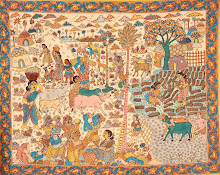Water Conservation
Water Harvesting
Waste Water Treatment
Agriculture/ Irrigation
Tourism
Industry
Domestic Use
Subscribe to:
Post Comments (Atom)
IDCA's Mission is to Alleviate Poverty and Mitigate Climate Change in India. It infors, inspires, empowers and involes NRIs/PIOs and Indian National to work together to help meet the basic needs of Millions in India. We focus on Water, Education, Livelihoods, Healthcare and Renewable Energy areas. We cooperate with othes in other areas. We promote, collaboration, networking, giving, sharing, learning and volunteering. We hope you will join us. www.idc-americ.org Email us: info@idc-america.org.

4 comments:
You will find interesting articles on Water at http://idcoa.cloverpad.org click knowledge Center and then water.
Upcoming Event
IDCA will celebrate World Water Day on March 28 at Oak Brook Library from
2 PM to 4:30 PM.
Speakers include:
Dr. Praksam Tata, Bharteeya Theertha-- Water and Sanitation Project in Andhra Pradesh village near Vizianagram.
Dr. Ann Feldman, president of Artistic Circle, North Brook, will talk about her documentary on Water Pressures- showing water problems in Rajasthan and some native solutions.
We will also show another 15 minutes documentary Amritam Jalam (Water is Nector) produced by Rajasthan Patrika about their campaign to restore more than 380 water structures for rain water harvesting.
You may also like to check:
http://akash-ganga-rwh.com for more information on Rain water harvesting.
Another good website is that of Tarun Bharat Sangh:
www.tarunbharatsangh.com An NGO focussed on creating thousands of check dams in Rajasthan. It was started by Mr. Rajendra Singh-the Waterman of India.
For overall view of water projects you may like to visit: www.indiawaterportal.org
More later. Mohan Jain, Ph.D.2/26/2009
Subject: New comment (#1) on "As we celebrate World Water Day on March 22, This month's topic is Water problems in India and how people are solving these and what can be done and what we can do at the grassroots level."
"Friends While it is true that we do have problems of "non supply" of water to the poorest (and so-called common man), the material FACTS that all of us should observe are the following: 1. India's annual average rainfall is about 1200 mm. Although the monsoon based water resource sways from a low of 900 mm to a high of 1500 mm, technologically it is possible to create conditions for average water supply to an extent of not less than 9000 L per capita, per day - to every one of the 1.15 billion population!) 2. The entire Coastal regions touching the Western Ghats account for an average of 2500 mm water, regularly precipitated during the six months of Monsoon period (June through Nov). It is during this period that the entire Deccan plateau on the eastern side of the Western Ghats experience drought and sever summer Heat. The Brahmaputra, the Mahanadi, various tributaries of the Ganga and the rivers Narmada-Tapi, Godavari, Krishna and even Kavery create flood havocs during the same period, in all the regions surrounding those rivers. Last year (2008) we saw an additional phenomenon of the Kosi River flooding vast areas (due to a Dam breach in the upper reaches in Nepal), destroying the lives of nearly 5 million village people. 3. While almost 95% of the waters in the Western coasts (drained through the West flowing Rivers) are wasted into the sea, the cases of the other bigger rivers (mentioned above) are not far different (except the Kavery River, which has been exploited to an extent of nearly 95%) Thus, it is clear that our problems are not due to non availability of water, but due "No Engineering". It is high time that our Universities and IIT's start training our youngsters in solving these problems, instead of gloating over the thought that each such institution is the best for exporting Trained manpower to the western world It is hoped that we would soon come to recognize the reality that India NEEDS our youngsters to solve OUR Problems"
Posted by Hariharan PV
You may want to learn more about water issues and World Water day by clicking: www.idc-america.org/upcoming.htm
Thanks. Mohan Jain
Every member of IDCA should use their contacts in India to push for local ordinances to harvest rain water in the monsoons, and also force municipalities to recycle their wastewater through simple primary and secondary treatment.
Simple filtration systems and biological treatment systems using lagoons are easy to install and operate, and should be implemented in all municipalities instead of letting the wastewater enter our water bodies, which are used by the poor for drinking water.
Citizen involvement, especially the students and professionals, is critical to raise the public consciousness regarding water quality in our urban and rural areas and provide for clean drinking water to the poor sections of our society. This is a fundamental right and responsibility of every citizen.
Post a Comment